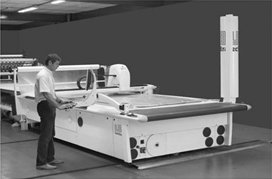1) Automatic blade cutting
Automatic blade cutting is the most highly developed and widely used computerized cutting system. In this system, numerically controlled knives cut multiple plies with great accuracy and speed. Information can be downloaded directly to the cutting system when needed. Easy data entry and instant communication with the main control unit allow technicians to preprogram multistep commands, set parameters, and start the process with a single keystroke.
The central control unit operates the components of the system such as the cutting head, cutter carriage, knife sharpeners, and conveyorized cutting table. A cutting head is a sophisticated mechanical component with the capacity to cut, mark, and drill as dictated by the computer. Automatic knife sharpening is done at preset intervals during the cutting operation. The cutter carriage moves the cutting head and provides lengthwise and crosswise motion during the cutting operation.
The reciprocating blade can be adjusted to the height of the spread and density of the fabric. Knife speed automatically adjusts to the forward speed of the cutting head. As the cutting head slows for corners, curves, or notches, the reciprocating blade also slows to reduce heat and possible edge fusing.
Most reciprocating knife systems use a bristle cutting surface (except for the low-ply system) and a vacuum to hold down the fabric. Bristle squares consist of 1.5-inch bristles that allow the computer-directed knife blade to cut down through the fabric into the bristle squares without being deflected, resulting in an accurate cut.
A plastic film is placed over the spread. When the vacuum is applied, the fabric is compressed to reduce the height of the spread and eliminate fabric movement during cutting. An intensified vacuum force is automatically applied to the area directly under the knife to further restrict fabric shifting.
Figure : Computer-controlled knife cutting
Figure : Cutting head
2) Laser cutting
Laser cutting focuses a powerful beam of light projected onto a minute area to cut fabric by vaporization. The fine, V-shaped beam is only 0.004 of an inch wide. The beam cuts without pressure on the fabric, which is a major advantage for some types of fabric, and the fabric remains immobile during the cutting operation.
Lasers cut with incredible speed (twice that of automatic knife cutting), accuracy, and multidirectional ability, but with some heat emission. Laser-cut edges are sharp and clean. The heat produced tends to seal fabric edges, which can be an advantage for fabric that ravels and a disadvantage for cutting multiple plies because edges may fuse together; thus lasers are used for single-ply cutting. Laser-cut garment parts are easier to assemble because they are consistent in size with smooth, sharp edges that align.
Laser cutters operate without any mechanical parts accept for the conveyor and plotting system, which operates at a cutting speed of 3 feet per second.
Lasers have been recognized for versatility in cutting small runs. Single-ply laser cutters also make it possible to cut by color or shade rather than by style. Multiple styles can be cut from one color and routed through the sewing room as one color. Lasers can be used to cut through a single ply of a bonded fabric such as would be used for shadow lettering.
Laser cutting does not suit the needs of all manufacturers, but it may be used for samples and low- volume cuts and along with more conventional blade cutters for other needs. Laser cutters can allow firms to produce on a make-to-measure or just-in-time basis. The continuous, rapid cutting of lasers helps to smooth out the flow of production and reduce in-process inventory However, widespread use of laser systems is still limited because of the high cost of investment in equipment. Lasers are not common for cutting garments, but growing in use for the production pattern, labels and appliqué, often in conjunction with embroidery.
Figure: Laser cutting machine
3) Water jet cutting
Water jet cutting is another computer-operated, multidirectional cutting method. Water jet cutting is performed by propelling a tiny jet of water (0.0010—0.0015 inch) through fabric at very high pressure (70,000 pounds per square inch). The forward edge of the jet stream shears the fabric as it moves along the cutting line but does not wet the fabric. The water jet can cut multiple plies without causing fusing, but it may fray and tangle the yarns of some fabrics, which makes it difficult to separate the plies. It is used when heat buildup must be avoided and water absorption is not important. At the present time its use is limited to cutting leather and vinyl fabrics.
Figure : Water jet cutting machine
Figure : Jet nozzle
A plasma jet is a computer-operated, high-speed, single-ply cutting device that offers many of the same features as a laser cutter but at a lower price. Plasma cutting was originally developed to satisfy a demand for high quality cutting on stainless steels and aluminium, but it can also be used to cut textile material. Cutting is achieved by means of a high velocity jet of high temperature ionized gas (argon). Cutting of this method is affected by the same quality of cut problem as was noted for laser cutting.






No comments:
Post a Comment